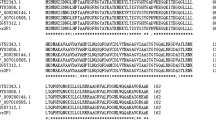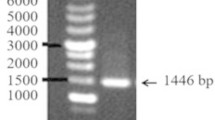Abstract
Multidrug-resistant bacteria are emerging as a major global threat to public health. Bacteriophages are an important source of antimicrobial enzymes and could be developed as an alternative antibiotic candidate. This study investigates the antibacterial capacity of the endolysin LysE against Aeromonas hydrophila. The endolysin LysE gene was cloned and expressed in Escherichia coli BL21 (DE3) cells. Purified recombinant LysE protein was tested for its antimicrobial activity against A. hydrophila. The study reveals that recombinant LysE protein was highly effective against Gram-negative bacteria when combined with antimicrobials that alter the permeability of the outer membrane. Specifically, the enzyme had the highest muralytic activity at pH 4, and maintained over 50% of the activity at pH 10. Moreover, endolysin displayed more than 50% activity even after 30 min of incubation at 100 °C. Also, endolysin LysE resulted in one log reduction in CFU/mL in 30 min and demonstrated antibiofilm capabilities when combined with EDTA. Interestingly, checkerboard assay showed its synergistic effects in combination with lower concentrations of colistin against A. hydrophila. Additionally, in vitro tests with Channa striatus kidney (CSK) cell lines do not show cytotoxic effects. Taken together, these findings suggest that LysE can be employed with outer membrane permeabilizers to expand the arsenal repertoire against Gram-negative bacteria in the aquaculture, food, and medical industries.







Similar content being viewed by others
Data Availability
All the data generated or analyzed during this study are included in this published article.
References
Rasmussen-Ivey CR, Figueras MJ, McGarey D, Liles MR (2016) Virulence factors of Aeromonas hydrophila: in the wake of reclassification. Front Microbiol 7:1337. https://doi.org/10.3389/fmicb.2016.01337
Yu HB, Rao PS, Lee HC et al (2004) A type III secretion system is required for Aeromonas hydrophila AH-1 pathogenesis. Infect Immun 72:1248–1256. https://doi.org/10.1128/iai.72.3.1248-1256.2004
Skwor T, Shinko J, Augustyniak A et al (2014) Aeromonas hydrophila and Aeromonas veronii predominate among potentially pathogenic ciprofloxacin and tetracycline-resistant Aeromonas isolates from Lake Erie. Appl Environ Microbiol 80:841–848. https://doi.org/10.1128/AEM.03645-13
Algammal AM, Mohamed MF, Tawfiek BA et al (2020) Molecular typing, antibiogram and PCR-RFLP based detection of Aeromonas hydrophila complex isolated from Oreochromis niloticus. Pathogens 9:238. https://doi.org/10.3390/pathogens9030238
Matamp N, Bhat SG (2019) Phage endolysins as potential antimicrobials against multidrug resistant Vibrio alginolyticus and Vibrio parahaemolyticus: current status of research and challenges ahead. Microorganisms 7:84. https://doi.org/10.3390/microorganisms7030084
Schmelcher M, Donovan DM, Loessner MJ (2012) Bacteriophage endolysins as novel antimicrobials. Future Microbiol 7:1147–1171. https://doi.org/10.2217/fmb.12.97
Guo M, Feng C, Ren J et al (2017) A novel antimicrobial endolysin, LysPA26, against Pseudomonas aeruginosa. Front Microbiol 8:293. https://doi.org/10.3389/fmicb.2017.00293
Chang Y (2020) Bacteriophage-derived endolysins applied as potent biocontrol agents to enhance food safety. Microorganisms 8:724. https://doi.org/10.3390/microorganisms8050724
Pallavi B, Puneeth T, Shekar M, Girisha S (2021) Isolation, characterization and genomic analysis of vB-AhyM-AP1, a lytic bacteriophage infecting Aeromonas hydrophila. J Appl Microbiol 131:695–705. https://doi.org/10.1111/jam.14997
Tamura K, Peterson D, Peterson N et al (2011) MEGA5: molecular evolutionary genetics analysis using maximum likelihood, evolutionary distance, and maximum parsimony methods. Mol Biol Evol 28:2731–2739. https://doi.org/10.1093/molbev/msr121
Lowry OH, Rosebrough NJ, Farr AL et al (1951) Protein measurement with the Folin phenol reagent. J Biol Chem 193:265–275
Oliveira H, Boas VD, Mesnage S et al (2016) Structural and enzymatic characterization of ABgp46, a novel phage endolysin with broad anti-Gram-negative bacteria activity. Front Microbiol 7:208. https://doi.org/10.3389/fmicb.2016.00208
Khakhum N, Yordpratum U, Boonmee A et al (2016) Cloning, expression, and characterization of a peptidoglycan hydrolase from the Burkholderia pseudomallei phage ST79. AMB Express 6:77. https://doi.org/10.1186/s13568-016-0251-7
Oliveira H, Thiagarajan V, Walmagh M et al (2014) A thermostable Salmonella phage endolysin, Lys68, with broad bactericidal properties against Gram-negative pathogens in presence of weak acids. PLoS One 9:e108376. https://doi.org/10.1371/journal.pone.0108376
Blasco L, Ambroa A, Trastoy R et al (2020) In vitro and in vivo efficacy of combinations of colistin and different endolysins against clinical strains of multi-drug resistant pathogens. Sci Rep 10:7163. https://doi.org/10.1038/s41598-020-64145-7
Majeed AS, Nambi KS, Taju G, Sahul Hameed AS (2013) Development, characterization and application of a new fibroblastic-like cell line from kidney of a freshwater air breathing fish Channa striatus (Bloch, 1793). Acta Trop 127:25–32. https://doi.org/10.1016/j.actatropica.2013.03.013
Stratev D, Odeyemi OA (2016) Antimicrobial resistance of Aeromonas hydrophila isolated from different food sources: a mini-review. J Infect Public Health 9:535–544. https://doi.org/10.1016/j.jiph.2015.10.006
Kutter EM (2013) Lysozyme. In: Stanley Maloy, Kelly Hughes (eds) Brenner's Encyclopedia of Genetics, 2nd edn. Academic Press, pp 292–293 https://doi.org/10.1016/B978-0-12-374984-0.00893-7
Shang X, Nelson DC (2019) Contributions of net charge on the PlyC Endolysin CHAP Domain. Antibiotics 8:70. https://doi.org/10.3390/antibiotics8020070
Tsugita A, Inouye M (1968) Purification of bacteriophage T4 lysozyme. J Biol Chem 243:391–397
Khondker A, Rheinstädter MC (2020) How do bacterial membranes resist polymyxin antibiotics? Commun Biol 3:77. https://doi.org/10.1038/s42003-020-0803-x
Funding
This work is supported by the Science and Engineering Research Board (SERB), India (Grant Number: PDF/2018/000811).
Author information
Authors and Affiliations
Contributions
PB and PTG conceived and designed the study and experiments involved. PB and PTG performed the experiments. PB, PTG, and GSK analyzed the data. GSK supervised the study. PB wrote the manuscript. PB, MS, PTG, and GSK reviewed and validated the result. PB acquired the funding for the study. All the authors read, commented, and approved the final manuscript.
Ethics declarations
Ethical Approval
Not applicable.
Conflict of Interest
The authors declare no competing interests.
Additional information
Publisher's Note
Springer Nature remains neutral with regard to jurisdictional claims in published maps and institutional affiliations.
Rights and permissions
About this article
Cite this article
Baliga, P., Goolappa, P.T., Shekar, M. et al. Cloning, Characterization, and Antibacterial Properties of Endolysin LysE Against Planktonic Cells and Biofilms of Aeromonas hydrophila. Probiotics & Antimicro. Prot. 15, 646–654 (2023). https://doi.org/10.1007/s12602-021-09880-7
Accepted:
Published:
Issue Date:
DOI: https://doi.org/10.1007/s12602-021-09880-7




